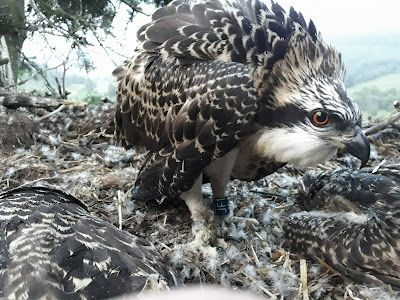Late summer and early autumn sees small numbers of Osprey staging in Cornwall on their southbound journey to west Africa. The wooded creeks and rivers that feed into Carrick Roads seem to be particularly favourable. Devoran Creek has had two individuals for the last few weeks and one of these juvenile birds was sporting a coded blue ring on the left leg. This instantly identified it as a Scottish bird as birds originating in England and Wales receive a colour ring on the right leg. Despite being quite showy the bird typically remained just out of range to read the ring, but with persistent observation and some digiscoping the ring was finally read as JF1.
This bird was ringed as a chick on 13th July this year near Monymusk, Aberdeenshire, by Grampian Ringing Group; one of a brood of three. On size, it was deemed likely to be a male and this is the first confirmed sighting of JF1 since leaving the nest.
 |
| JF1 in the nest just after ringing |
With various Ospreys being seen elsewhere in the county it is very much worth looking out for these impressive birds and, if you’ve got your eye in, reading a colour ring! Thanks to Greg Wills for the words and pictures and Ewan Weston for the photo of JF1 in the nest.









